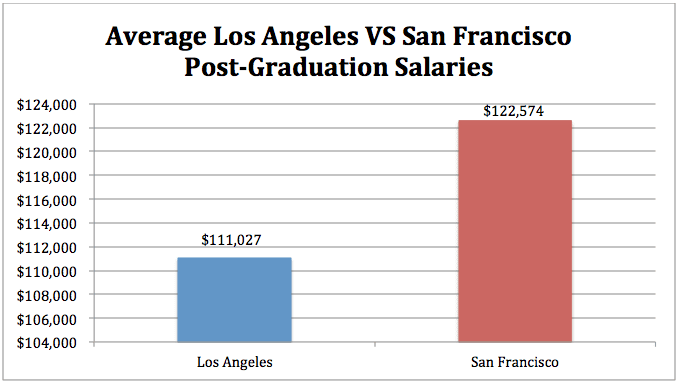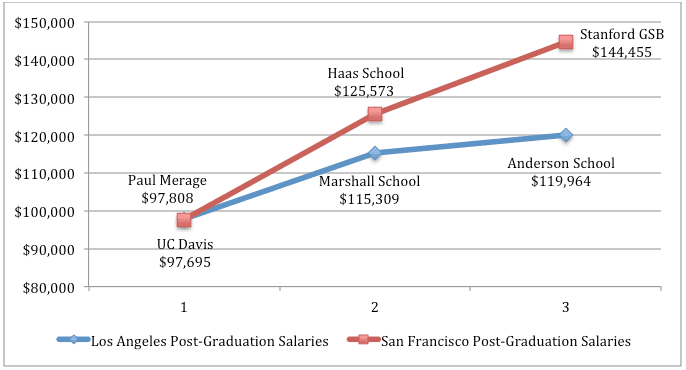Why U.S. News & World Report Changed Its Rankings Methodology

For prospective MBAs, the most difficult step towards a business school degree is knowing where to start. And for many, the most obvious is researching the near-endless amount of college ranking sites. After years of scandals and much-publicized doubts, however, the authority of these rankings may be in question.
In a recent Philadelphia Magazine op-ed, writer Sandy Hingston asks, simply, “Can We All Agree Now That College Rankings Are Bunk?”
Hingston’s critique, which highlights in relative inexactness of the college ranking sites, is not the first of its kind. In 2011, popular New Yorker writer Malcolm Gladwell wrote wrote about his issue with college rankings. In “The Order of Things,” Gladwell notes that the outcomes of students sometimes do not match college reputations.
Principally, Gladwell, the author of the massively popular 2008 book Outliers: The Story of Success, found fault in how publications like U.S. News & World Report conducts rankings. He writes, “the magazine sends a survey to the country’s university and college presidents, provosts, and admissions deans (along with a sampling of high-school guidance counselors) asking them to grade all the schools in their category on a scale of one to five.”
In regards to the scoring system, Gladwell cites numerous incidents that say reputation weighs too heavily. This is important considering that personnel often do not know what other schools are actually like. To illustrate, he brings up a different ranking from the time, with much different results:
“In an article published recently in the Annals of Internal Medicine, Ashwini Sehgal analyzed U.S. News’s ‘Best Hospitals’ rankings, which also rely heavily on reputation ratings generated by professional peers. Sehgal put together a list of objective criteria of performance—such as a hospital’s mortality rates for various surgical procedures, patient-safety rates, nursing-staffing levels, and key technologies. Then he checked to see how well those measures of performance matched each hospital’s reputation rating. The answer, he discovered, was that they didn’t. Having good outcomes doesn’t translate into being admired by other doctors. Why, after all, should a gastroenterologist at the Ochsner Medical Center, in New Orleans, have any specific insight into the performance of the gastroenterology department at Mass General, in Boston, or even, for that matter, have anything more than an anecdotal impression of the gastroenterology department down the road at some hospital in Baton Rouge?”
He goes on to say, “reputational ratings are simply inferences from broad, readily observable features of an institution’s identity, such as its history, its prominence in the media, or the elegance of its architecture. They are prejudices.”
In addition, Gladwell notes important economic distinctions that many college ranking sites ignore. For the sake of simplified ranking, small private schools are compared to massive public institutions and scored equally. But doing so overlooks the economic makeup of enrolled students, funding, and much more.
A Modern Change for U.S. News
Seven years later after Gladwell’s critique, U.S. News & World Report continues to refine its rankings method. The publication’s new changes aim to emphasize economic mobility. This comes just one year after Politico revealed that the upper-echelon schools continually reward students that are already wealthy. That discovery may not be “groundbreaking,” but the data is still jarring. Many of the country’s most well-known institutions enroll more students that come from the top 1 percent of income-earning families than the bottom 60 percent of earners.
Why is this important and why did U.S. News & World Report need to change? Like Gladwell said seven years prior, prejudices feed the rankings and the economics factors are biased. And the amount of inequality it expanded may have been profound.
The Politico study outlined these key factors in the previous U.S. News ranking formula:
- Student Performance
- Lower Acceptance Rates
- Higher Performance on Surveys
- Alumni Donations
These factors weigh heavily for students from more affluent backgrounds. U.S. News, like many of its popular ranking competitors—such as the Financial Times and Bloomberg—rely on similar scoring systems, which often left the economically disadvantaged out of the equation.
The aforementioned 2017 Politico report points to the lengths some schools and state governments went to meet the U.S. News standards:
“Colleges go to great lengths to rise in the rankings. The president of one school ranked in the top 20 said the college caps classes at 19 students, simply because the rankings reward schools for keeping classes under 20 students. In some states, the rankings are built into accountability systems for university presidents. Arizona State trustees put a bonus pegged to the rankings in the president’s contract. In Florida, Gov. Rick Scott set a goal to ‘achieve the first top-10 research public university and a second-ranked public university in the top 25.'”
Robert Morse, U.S. News Chief Data Strategist, says of the changes; “There is an active and ongoing debate about how to best measure quality in education, and we pay close attention to that debate. Over time, our ranking model has put more emphasis on outcomes measures … As part of this evolving process, we’ve wanted to measure whether schools were successful at serving all of their students, regardless of economic status.”
The publication will begin accounting more for social mobility and rewarding of Pell Grants. As well, Morse says, schools that enroll a higher percentage of lower-income students will get more credit for graduation rates. In total, “13 percent of a school’s rank is now dependent on the economic diversity of its campus.”
Will Other College Ranking Sites Follow?
The changes for U.S. News‘s rankings may cause a slow sea change for its competitors. For its undergraduate ranking, SAT/ACT scores now factor less in the overall score. This, like many of the highlights indicated above, is because standardized tests are highly correlative with income. The acceptance rate boost is being completely removed as well.
The dismissive stances from the likes of Hingston and Gladwell likely will not be re-mediated immediately. After all, college ranking sites will likely remain among most popular resource for school research. However, a more modern evaluation can pay dividends in the long-term. And for U.S. News‘ prime competitors, following suit may be an unavoidable remedy.
The next annual U.S. News ranking of the country’s best business schools will arrive early next year. Whether the new changes will weigh heavily in the rankings remains to be seen.
Millennial Men Taking on Parental Leave, and More – Toronto News

Toronto’s finest business schools have been contributing to social, political, and scientific advances this week. We’ve laid out the highlights below.
How Testosterone May Be Influencing Men’s Purchasing Decisions – The Globe and Mail
Nature Communications recently published research from Western University Canada’s Ivey Business School that explored the relationship between testosterone levels and luxury brand purchases in men. The study finds that levels of the hormone, typically associated with sex drive and masculine features, could play a role in predicting shopping choices.
The study involved 243 men between the ages of 18 and 55, divided into two groups. The men in one group were given doses of testosterone, and those in the other group received a placebo. Those with higher levels of testosterone were more likely to purchase high-end brands than those with lower levels of the hormone. Researchers posited that this is due to an evolutionary drive to demonstrate high social status, and therefore a high mate value.
According to the study, testosterone, “elevates men’s desire to promote their social status through economic consumption.”
You can read more about the study here.
How Millennial Men Can Champion Workplace Equality – Forbes
Though, externally, it seems society has made remarkable strides toward gender equality, subconscious bias is more difficult to measure. Harvard’s Project Implicit study, however, attempts to gain data about implicit gender bias. Nearly 80 percent of participants were more comfortable associating men with the work and public spheres and women with the domestic spheres than vice versa.
According to the research, working mothers tend to be faced with skepticism surrounding their commitment and ability to do their jobs when they return from parental leave. However, millennial fathers, may have the chance to help alter this perspective. In her Forbes article, Mary Beth Ferrante sites the work of Erin Reid, Associate Professor at McMaster University’s DeGroote School of Business. Her work explains the concept of breadsharers, or, “husbands who value enabling each partner to pursue their work and family goals.”

Erin Reid, Associate Professor at McMaster University’s DeGroote School of Business, notes that the more millennial men take parental leave, the more normalized the practice becomes / Photo via gsb.stanford.edu
Milliennial fathers are more open to breadsharing, and could thus influence the way new mothers are seen in the workplace. Ferrante insists that it is essential for men to take their full parental leave in order to challenge implicit bias surrounding the roles of men and women in the workplace and at home.
You can read Ferrante’s full piece on millennial men influencing parental leave here.
What is the Most Democratic and Effective Way to Govern a City the Size and Economic Import of Toronto? – The Globe and Mail
Richard Florida, professor at the University of Toronto’s School of Cities and Rotman School of Management, and Alan Broadbent, Chair of Avana Capital and Maytree, recently co-authored an article for The Globe and Mail that explores Toronto’s future in the wake of Doug Ford’s announcement that he plans to drastically reduce the size of Toronto’s city council.
With different parties vying for a say in how Toronto ought be governed moving forward, the co-authors insisted that, “The province and the country as a whole can’t afford to have an economic entity of this size and economic importance kicked around like a proverbial political football.” Florida and Broadbent advocate for finding a system that would empower the city rather than dividing it.
The two say:
“We need to create a new governance system that enables Toronto to truly govern itself, act on its strengths and address its many problems and challenges. The future prosperity of our city, province and nation depends on it. It’s an issue that must be front and centre in this mayor’s race and beyond.”
You can read more about Toronto’s economic future here.
Forbes, Statista Analyze The Best U.S. Employers for Women

Forbes, in partnership with German data company Statista, surveyed over 40,000 U.S. employees (including 25,000 women) that worked for companies that had at least 1,000 total employees in an effort to find which companies were the best US employers for women. While several big-name companies earned high marks, one particular Iowa-based company managed to stand out among the competition.
The first set of criteria Forbes and Statista analyzed to calculate its best US employers for women ranking centered around factors such as working conditions, diversity, and “how likely they’d be to recommend their employer to others.” When accounting for the men in the survey, in contrast to the women that were asked the same set of questions, scores were adjusted if the differences if answers became apparent. For example, Statista would adjust scores if men in the survey said a company had a lot of diversity, but women said that the same company did not.
The following set of criteria used in the survey, specifically for the female respondents, focused on “on factors such as parental leave, discrimination, and pay equity,” as well as nominated companies outside of the one they happen to work for. “The final list ranks the 300 employers that both received the most recommendations and boast the most gender diverse boards and executive ranks,” Forbes says.

Des Moines, Iowa company Principal Financial Group was the best U.S. company for women, according to Statista data.
Principal Financial Group, based out of Des Moines, Iowa, earned the highest honors for the 2018 ranking, with an official score of 91.4. The company, ranked 210th overall on the Fortune 500 list, employs 9,978 U.S. workers, nearly 60 percent of which are women. Speaking with Forbes, Kerry Gumm, the Principal Capital Director of Human Resources Strategy, says, “It really does start with the culture of the organization.”
“You can have a holistic life if you’re part of this organization,” she adds. “I’ve not felt the need to compromise in any way.”
Principal Financial Group earned high recommendations because of its benefits, which include “flexible work schedules, prenatal care programs, and an onsite childcare center.” The company also manages an annual review of all of its pay practices to better combat any potential biases, alongside an anonymous call center to help discuss compensation disputes. Not to be outdone, the company also implements rigorous standards in helping its own employees earn promotions, of which include “three women’s networks for those in leadership, technology, and sales roles.” In contrast to many of the companies listed in the aforementioned Fortune 500 listing, 42 percent of executive roles and 45 percent of the boards seats are held by women Principal Capital Group.
The University of Pennsylvania Health System, more commonly referred to as Penn Medicine, earned the number two spot on the ranking. The organization has over 35,000 U.S. employees; the third highest among the top ten ranked companies. With a significantly larger employee base than Principal Financial, Penn Medicine also has one of the largest percentages of female employees in the country at 77 percent. This also includes 55 percent women in the organization’s executive roles, as well as five out of its seven CEOs.
Card manufacturer Hallmark, based in Kansas City, Missouri, rounded out the top three. The company sports the smallest employee base out of any company in the top 10, with 2,500 U.S. employees. However, Hallmark featured an even larger portion of U.S. female employees than Penn Medicine, with a figure of 83 percent overall. About 70 percent of the Hallmark board is also held by women.
Several of the nation’s most prominent universities also managed to land in the top 50 of the new ranking, the highest of which was Harvard University at 9th overall. New York University, UVA, Stanford, and Emory University also earned high honors in the 2018 best US employers for women ranking.
2018 Best US Employers for Women
| Ranking | Company | # of U.S. Employees |
|---|---|---|
| 1 | Principal Financial Group | 9,978 |
| 2 | Penn Medicine | 35,273 |
| 3 | Hallmark | 2,500 |
| 4 | BayCare | 25,600 |
| 5 | Oregon Health & Science University | 15,642 |
| 6 | Keller Williams Realty | 154,000 |
| 7 | Boston Children's Hospital | 5,001 |
| 8 | Providence Health & Services | 82,000 |
| 9 | Harvard University | 18,724 |
| 10 | Gwinnett County Public Schools | 23,300 |
Click here to see the 2018 entire ranking.
Babson Olin Graduate School of Business Names Keith Rollag New Dean

Earlier this month, the Babson College F.W. Olin Graduate School of Business named its new dean: Keith Rollag. A management professor with over 17 years of experience teaching entrepreneurial leadership at Babson, Rollag was chosen for his campus leadership and his vision for the graduate school’s future. Continue reading…
Merage Alum Paves New Roads at Toyota, and More – Los Angeles News

We’ve rounded up the biggest stories coming out of business schools in the Los Angeles metro this week.
Zack Hicks: Toyota’s Leader for the Digital Future – UCI Paul Merage Newsroom
Zack Hicks, alumna of the Executive MBA program at the Paul Merage School of Business at University of California, Irvine, is leading the charge for digital intelligence at Toyota Motor North America. Using his experience from Merage’s EMBA program, Hicks charges forward as Toyota’s first-ever Chief Digital Officer, and CEO/president of Toyota Connected, a big data company that looks to use technology for improving the driving experience.

Zack Hicks, Merage EMBA alum and Toyota’s Chief Digital Officer, and CEO/president of Toyota Connected
In 22 years with the company, Hicks has served in a wide variety of departments, from financial services to IT. When deciding to go back for his MBA, he sought a program that would offer a new set of tools to draw from as he advanced in his career.
“I wasn’t interested in just checking the box, and I didn’t want to learn just theoretical aspects of business,” he commented. He also reflected on Merage’s diverse faculty and real-life business education: “I knew that made Merage a much richer learning environment,” he said in a recent interview with the UCI Paul Merage Newsroom.
Read more about Hicks’ work at Toyota and the EMBA program at Merage here.
Six Los Angeles Entrepreneurs Share Why Their City Is So Great For Starting a Business – Forbes
Though it may be better known as a city of dreams for Hollywood hopefuls, Los Angeles is also increasingly becoming a hub for business and entrepreneurship. Forbes recently compiled the insight of six members of the Forbes Los Angeles Business Council, sharing their thoughts on why Los Angeles is a top destination for entrepreneurs.
L.A. business leaders across a variety of industries shared their thoughts on the city as a perfect startup environment, including the city’s strong tech community, influx of startup talent, and its ‘second-mover’ advantage over Silicon Valley. “LA has the second-mover advantage when it comes to the startup scene,” commented Anna Nguyenova of TubeScience. “The office and living rent is significantly cheaper, there is more space to grow, more land to build on and it has one of the highest number of students graduating with a STEM degree.”
You can read more insights from L.A. entrepreneurs here.
G3X Conference Keynote Jan Masaoka to Examine the Challenges and Opportunities of the Nonprofit Sector – Mihaylo Newsroom
This August, the Mihaylo College of Business at California State University, Fullerton will host the weeklong G3X Conference to discuss issues in the social profit and social enterprise fields. The conference will be presented by the Mihaylo College Gianneschi Center.
Among the keynote speakers for the week will be Jan Masaoka, CEO of the California Association of Nonprofits. Masaoka has been in the social sector in California for many years, serving from 2007 to 2015 as editor-in-cheif for Blue Avocado, an e-magazine for philanthropic professionals. In 2003, the Nonprofit Times named her the Nonprofit Executive of the year. In advance of the conference in August, Masaoka shared her thoughts on philanthropy and success in the field with Mihaylo.
“Start and perhaps stay with work that is close to the action,” Mihaylo commented, offering advice to young people looking to join the social profit sector. “Instead of seeking to be an art grantmaker, put in the time as the office manager of a community theater.”
You can read more about Masaoka and the upcoming G3X conference here.
The California MBA Program Guide

If you’re looking to earn a California MBA, where should you go to school? Should you choose a top MBA program in Los Angeles or San Francisco? Both cities offer beautiful weather, gorgeous beaches, and world-class business education, but is one location better than the other?
Los Angeles vs. San Francisco
To get started, it’s necessary to compare the cost of living in Los Angeles and San Francisco. According to Numbeo, the world’s largest database containing user contributed data about cities, San Francisco is far and away the more expensive place to live. You would need $7,748.24 in San Francisco, CA to afford the same lifestyle that you can have for $5,700 in Los Angeles. That’s just over $2,000 more per month needed to live in San Francisco, and here’s how that’s broken down.
- Consumer Prices:98 percent higher in San Francisco
- Rent Prices: 51 percent higher in San Francisco
- Restaurant Prices: 62 percent higher in San Francisco
- Groceries Cost: 8 percent higher in San Francisco
- Local Purchasing Power: 77 percent higher in San Francisco
Right off the bat, it’s obvious that the cost of rent (real estate) is what will eat up most of your paycheck in San Francisco, but is that offset by anything? Here are the other things to consider when choosing between San Francisco and Los Angeles.
- Industries
- Los Angeles is ranked top in the country for manufacturing with over 500,000 workers in the industry. Other top industries include banking and finance (more than 100 foreign and domestic banks), entertainment, and tourism.
- San Francisco, on the other hand, is known as Silicon Valley (with San Jose) for its technology companies and startups (Intel, Apple, Genentech, Google, Uber, and Twitter). It’s also a great city for finance, global business, medical science, biotechnology, tourism, and fashion apparel (home of the Levi Strauss & Co headquarters).
- Economic Development: According to the Center for Jobs, San Francisco far and away outperforms Los Angeles in terms of economic growth and development with the Bay Area growing year-over-year while LA has struggled with almost consistent decreases.

- Top Companies: California is home to 53 Fortune 500 companies, second only to NYC. And more of those companies are located in the Bay Area compared to Los Angeles. San Francisco is home to Apple (3), McKesson (5), Chevron (19), and Wells Fargo (25). While Los Angeles is home to Aecom (161), CBRE (214), and Reliance Steel & Aluminum Co (320).
Los Angeles vs San Francisco MBA Programs
The next step is to compare the top three MBA programs in each city. In particular, we wanted to take a look at the tuition rates (two years), GMAT averages, and post-graduation salaries at each program in each city to get a well-rounded picture.
There are a few things to note right away.
- San Francisco is home to more highly ranked MBA programs with two ranking in the top ten on every list. However, it’s important to note that both cities have programs that rank well and are considered top tier schools.
- The average tuition in each city is fairly even. However, the most expensive ($137,00) and the most affordable ($77,000) schools are located in San Francisco, whereas Los Angeles is more even regarding tuition across the board.
- You’ll need a better GMAT score to go to a school in San Francisco, and that GMAT score translates into a higher salary after graduation. San Francisco graduates earn about $11,000 more per year compared to their LA counterparts.
Here’s how it all breaks down per school.
Top 3 Los Angeles MBA Programs
Anderson School of Management – UCLA
The UCLA Anderson School of Management offers a full-time MBA, a part-time MBA, an Executive MBA, and a UCLA-NUS Global MBA (Asia Pacific) program. It’s considered one of the top business schools in the world, ranking 6th in the Economist, 15th in Forbes, 16th in the U.S. News & World Report, and 25th in Financial Times.
- Tuition Rates (two years): $117,176
- GMAT Averages: 719
- Post-Grad Salaries (Mean): $119,964
Marshall School of Business – USC
The Marshall School of Business at USC offers a full-time MBA program, a part-time MBA, an Executive MBA, and IBEAR (International Business Education and Research) MBA, and an Online MBA program. The school’s full-time MBA program is ranked: 20th in the U.S. News & World Report, 33rd in Forbes, 59th in Financial Times, and 65th in the Economist.
- Tuition Rates (two years): $116,361
- GMAT Averages: 703
- Post-Grad Salaries (Mean): $115,309
The Paul Merage School of Business – University of California, Irvine
The Paul Merage School of Business has both a full-time MBA program as well as a part-time fully-employed MBA program. In addition, the school offers an Executive MBA and a Health Care Executive MBA program. The business school is ranked highly across multiple rankings including 41st in Forbes, 42nd in the U.S. News & World Report, 56th in the Economist, 64th in Financial Times.
- Tuition Rates (two years): $87,661
- GMAT Averages: 652
- Post-Grad Salaries (Mean): $97,808
Top 3 San Francisco MBA Programs
Haas School of Business – UC Berkeley
The Haas School of Business offers a full-time MBA, part-time MBA, and Executive MBA program. Haas is ranked as one of the top business school’s in the world ranking in the top ten on every list: 7th overall in U.S. News & World Report and 7th overall in the Economist, as well as 9th overall in Forbes, and 10th overall in the Financial Times.
- Tuition Rates (two years): $117,444
- GMAT Averages: 725
- Post-Grad Salaries (Mean): $125,573
Stanford University Graduate School of Business
The Stanford University Graduate School of Business offers only a full-time MBA program, but it’s one of, if not the top two-year program in the world. When looking at how Stanford GSB stacks up to the competition, the rankings speak for themselves with all in the top ten and most in the top five, including: 1st overall in the Financial Times, 2nd overall in Forbes, 4th in the U.S. News & World Report, and 9th in the Economist.
- Tuition Rates (two years): $137,736
- GMAT Averages: 733
- Post-Grad Salaries (Mean): $144,455
UC Davis Graduate School of Management
At the UC Davis Graduate School of Management, MBA applicants can apply to the full-time MBA or the part-time MBA program. Once again, UC Davis is one of the top schools in the world, ranking 37th in the U.S. News & World Report, 63rd in Forbes, and 67th in the Economist.
- Tuition Rates (two years): $77,698
- GMAT Averages: 669
- Post-Grad Salaries (Mean): $97,695
California MBA Breakdown in Charts
When breaking down the data between MBA programs in Los Angeles and San Francisco, here’s what it looks like
California MBA Tuition (Los Angeles vs. San Francisco)
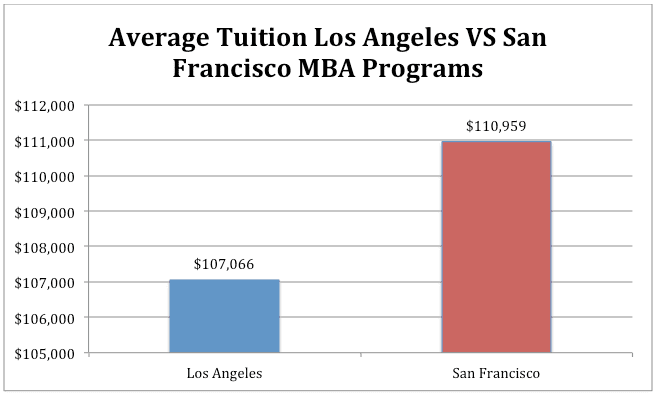
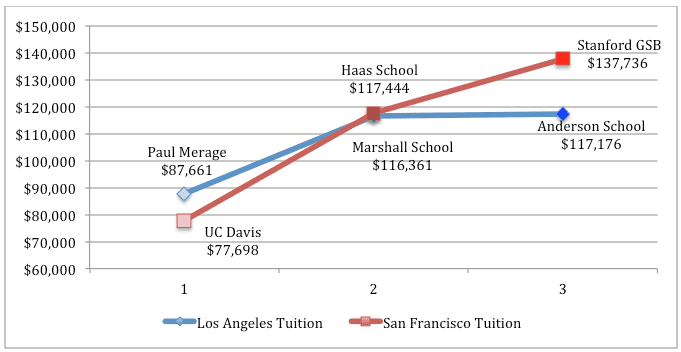
California MBA GMAT Averages
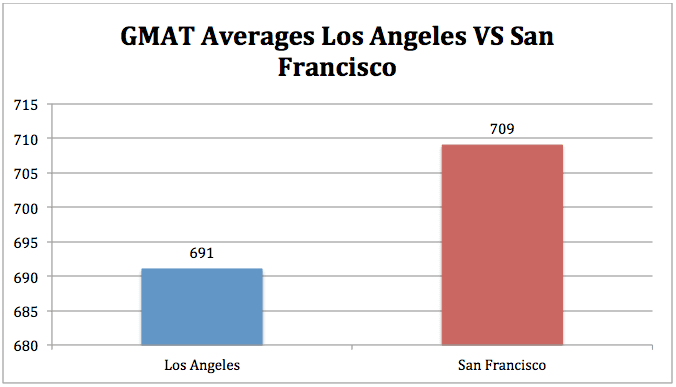
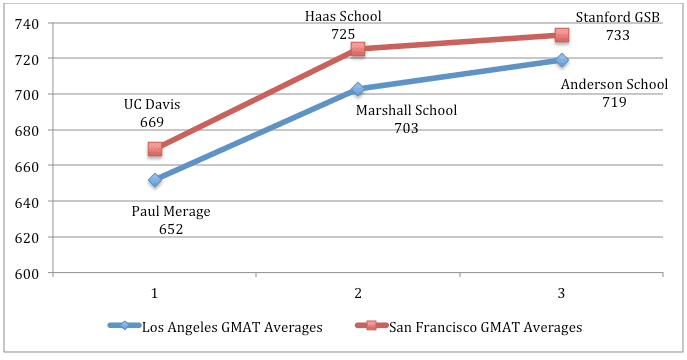
California MBA Post-Graduation Salaries
